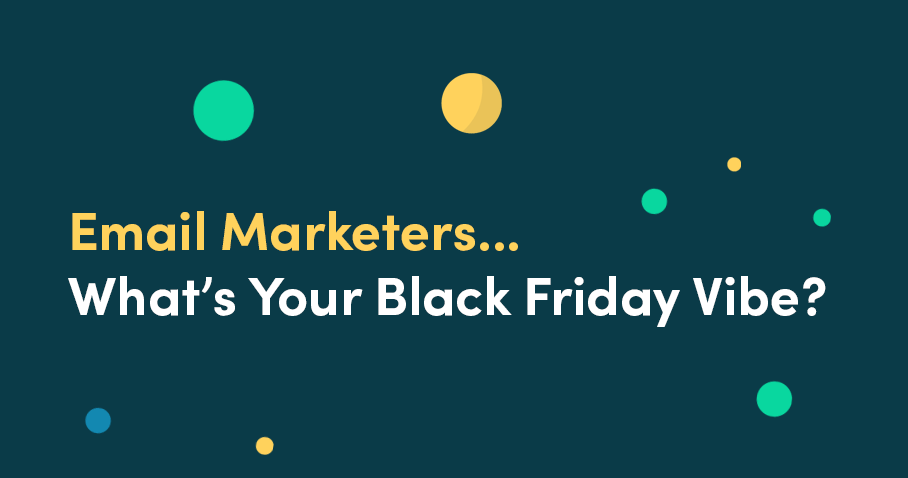Email Marketers: What's Your Black Friday Vibe?


It's almost upon us. The most awaited and slightly dreaded calendar event for email marketers and retail brands. BLACK FRIDAY!
Historically it is the biggest consumer spending weekend of the entire year. However, more than ever we are seeing mixed feelings around taking part in this worldwide event even from some of the bigger brands.
Knowing where to start is hard; we get that. However, our email heroes take BFCM very seriously, so let's take a look at the history of Black Friday and some awesome tips to get the most from Black Friday this year.
Black Friday has been a global retail event for a long time now. That emerged from a set of incidents specific to a particular time and place. Many brands that we speak to often struggle to find the right way to position themselves in this annual tidal wave of offer emails and discount-soaked social media channels.
We get a range of opinions – from fear to excitement. And there are the brands, like the consumers they serve, who simply want nothing to do with it anymore. The fear in not getting it right generally lays in the immense cost of resources, ad spend and the challenge of achieving any kind of cut-through during this period.
We have thoughts. But first…
A short history of Black Friday
There are many myths around the reason for Black Friday, some believable and some totally bonkers! One is that for retailers, Black Friday is the first day in the year when a business's bottom line will go into credit...into the BLACK. Hence Black Friday.
However, Black Friday began in America and is deeply connected with the Thanksgiving holiday weekend. Long before online shopping and when high street stores were the only place to shop until you dropped an opportunity was spotted. This was to shift stock and clear space for the upcoming Christmas season. Retailers opened their doors on the Friday following Thanksgiving and offered consumers discounts no one could say no to. It quickly became a tradition fixed into the US calendar.
We know Black Friday isn't all about amazing bargains. It is also associated with some of the uglier aspects of consumer culture, from retailers aggressively undercutting each other and selling at a loss, to rowdy scenes at stores.
With the rise of ecommerce, Black Friday went global pretty quickly bringing its reputation for quick revenue wins and ugly consumerism with it.
What started out as a stock-clearing sales event tied to a particular local holiday, soon gained the top spot in the marketing calendar of all businesses and consumers. Meaning that in the super crowded and noisy season in which Black Friday is, brands are finding it hard to get a space at the table let alone a share of the roast. So what to do?
Happy Black Friday, to those who celebrate
Black Friday sales are not the right move for every business. Not everyone has warehouses full of stock to get rid of or even any physical products at all. Others position their product on something other than cost. How could they handle discounting at Black Friday time? They probably can’t, and shouldn’t try.
But we're not saying to sit back and do nothing over the biggest shopping weekend of the year. We think ignoring Black Friday completely is a missed opportunity. To not show up at all = a massive risk. Consumers are trained and alert to brands being more active in this period, and to simply absent yourself means being invisible to them when they are most active and engaged. And that's even if you're not going to do something for BFCM - you should still announce that in some form. If you don't, your subscribers will probably be anticipating an announcement = stalling their order = damaging your revenue. Lead your subscribers and give them the context they need, otherwise they'll likely go somewhere else.
A note on regulated sale seasons in Europe
Consumers may not realise but there are rules when it comes to Black Friday Sales. This is because some European states have regulated when retailers are permitted to operate sales. Generally, once in winter and once in summer but it varies from country to country and sometimes even from region to region (looking at you Italy).
The countries where sales periods are regulated are Belgium, Denmark, France, Greece, Italy, Luxembourg, Poland, Romania, Slovenia, and Spain. Portugal doesn’t set a defined period but limits the maximum duration in a year to four months.
Even countries without regulated sales periods will have set dates for sales.
The point here is that across much of Europe, Black Friday is seen to compete with local retail traditions. However, consumers will have grown up with their own cycles of sales and discounts, and retailers too will have an established rhythm. Both will be planning their budgets and spending accordingly.
Retailers it is super important to be aware of local habits and regulations when planning a sales event.
Cut the cloth to fit
Let’s take a look at a couple of potential Black Friday models for businesses that fall outside of the big box retailer profile. How should they ‘do’ Black Friday in a way that aligns with their business model, brand, ethics and customer expectations?
Software developer of specialist small business services
- Model: selling tiered annual subscriptions to a niche retailer group. High value, low volumes
- Challenges: the purchase cycle is yearly. Orders fall off in Q4 because the customer base is busy with BF
- Key objectives: increase demos and appointments with sales reps
- BF Strategy: the business shouldn’t create any BF offers or promotions, as that would cannibalise and fatally undermine the yearly subs model. Instead, demonstrate expertise and affinity with the core market. Aim to be front of mind with users and decision makers through BF-oriented content marketing. Develop and give away resources that make life easier for end-users, and think-pieces targeted at the C-Level. Create relevance and urgency by making the resources available for free for a limited time. Target leads for demos, but don’t forget about retaining existing customers too
B2C sustainable everyday fashion brand
- Model: marketplace for small producers of high-quality, sustainable, ethical clothing
- Challenges: the brand position is antithetical to fast fashion and impulse buying leading to waste. BF isn’t a good fit
- Key Objectives: sustainable MoM growth, customer acquisition and repeat purchases
- BF strategy: be visible in the BF period by speaking to brand values and committing to donating a share of profits. Like Bandcamp Friday, 100% of sales to go vendors. Run a contest – ask customers to build wish lists of items, then run a Win Your Wishlist contest applicable to anyone who spends > $X in Black Week
D2C premium item brand
- Model: producer of a small range of aspirational, big-ticket consumer items that sell directly to customers through their own ecommerce site
- Challenges: long consideration phase and a premium pricing strategy that makes discounting difficult
- Key objectives: lead acquisition, shorter consideration time and improved conversion rate
- BF strategy: focus on subscriber acquisition via social and influencer channels in the quieter months of Q3, driving collection of zero-party data through quizzes and conversational tools. Double-down on personalised, automated lead nurture and aspirational brand content and collateral. Create a VIP culture around list membership and, if possible, use the start of Q4 to trail exclusive new product announcements and launches, offering early-bird pricing or availability, limited edition products or free personalisation. Leverage influencer content or UGC to create aspiration. Use BF as a launch pad for the gifting season
General approaches to Black Friday
We all know by now that Black Friday sales are starting earlier and lasting longer. Therefore retailers need to make the most of this time by adapting their strategy and start planning as early as possible. We suggest starting planning at the beginning of Q2 at the latest. Yep, that's April.
Another great tip is to plan backwards and work as soon as possible with finance and inventory to understand what will be available. Start with product and build your strategy from there.
Focus on feeding the top of the funnel in Q3. New subscribers added in this period will likely form an outstanding percentage of BF customers, and may only really engage in this period. Consider segmenting these subscribers and channelling BF messaging at a higher frequency from your engaged audience.
Offer a peak season opt-out to long-life subscribers, or offer early access – especially if stock levels might be an issue.
Run an unannounced, very limited flash sale six weeks out. It will stress test your creative, strategic and operations plans. Plus while some customers will get a taste, most will miss out, creating a buzz around the main event.
Set targets parallel to last year or, if this is year zero, define objectives relative to resources (including staff and contractor hours – don’t burn folks out chasing rainbows). View year zero as a test run for next year.
Record everything – planning, resources, decisions, results, especially startups. Your future colleagues will thank you, and you may even thank yourself.
Plan for a post-BF sales shadow. It’s a good time to schedule new product or feature announcements or start demand for the gifting season.
Over to you, superheroes.
Suggested Reading From The Blog
Most Popular Blogs
Top 10 Email Marketing Platforms for 2021
6 Minute Read
Editor's Picks
Meet our newest email superhero, Kiran Patel
2 Minute Read
Klaviyo Email & SMS Product Updates: October 2021
4 Minute Read
10 Ways to Improve Email Marketing Open Rates
6 Minute Read
